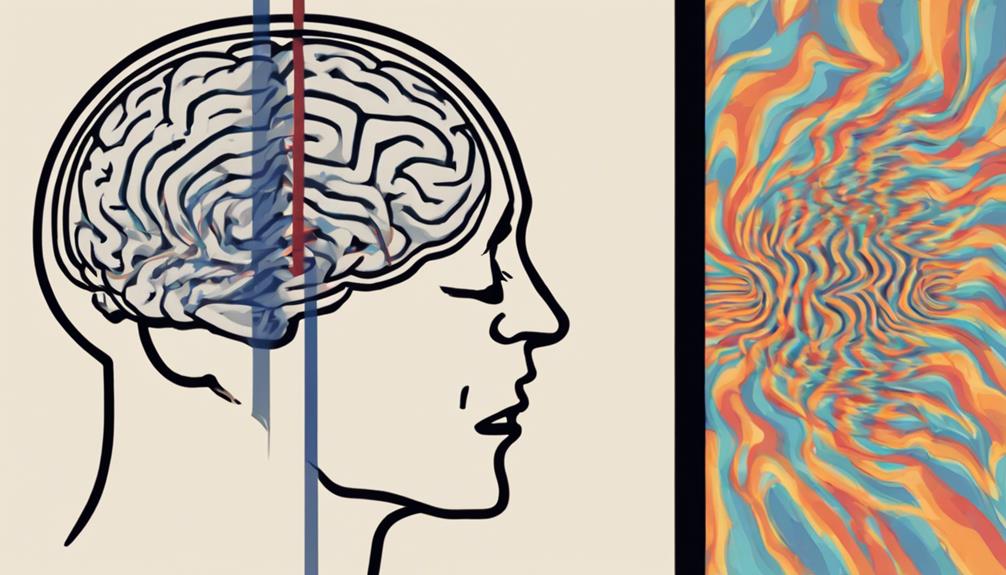Neurological changes in the brain during hypnosis involve significant alterations in brainwave patterns, functional connectivity, states of consciousness, brain regions, and neurotransmitter activity. These changes reflect the impact of hypnosis on neural mechanisms, showcasing shifts in brainwave activity towards theta waves which are linked to suggestibility and focused attention. Functional connectivity alterations modify brain network synchronization, particularly affecting the default mode network responsible for introspection. Brain regions involved in cognitive processing and suggestibility show increased activation and structural changes. Moreover, neurotransmitter activity shifts influence cognitive functions. The profound impact of hypnosis on the brain's neural mechanisms is evident.
Brainwave Patterns During Hypnosis

One of the key elements studied in the realm of neurological changes during hypnosis is the alteration of brainwave patterns that occur in individuals undergoing hypnotic induction. During hypnosis, there is a notable shift in brainwave activity, with a particular focus on theta waves.
Theta waves are associated with deep relaxation, creativity, and enhanced cognitive processing. Research indicates that the increase in theta wave activity during hypnosis may correlate with the heightened suggestibility and focused attention experienced by individuals under hypnosis.
Studies have shown that theta waves play a crucial role in facilitating cognitive processes such as memory recall, problem-solving, and learning. The presence of theta waves during hypnosis suggests a state of deep relaxation combined with heightened awareness, which may contribute to the receptiveness of hypnotic suggestions.
Understanding the impact of theta waves on cognitive processing during hypnosis is essential for unraveling the mechanisms underlying the hypnotic state and its potential therapeutic applications.
Functional Connectivity Changes
Exploring the realm of neurological changes during hypnosis, researchers investigate the impact of hypnosis on functional connectivity within the brain. Functional connectivity refers to the synchronization of activity between different brain regions.
Studies have shown that during hypnosis, there are alterations in the default mode network (DMN), a set of brain regions that are active when the mind is at rest and not focused on the outside world. The DMN plays a crucial role in self-referential thoughts and introspection.
Hypnosis has been found to modulate the connectivity strength within the DMN, leading to changes in how different regions communicate with each other. These changes in connectivity strength may underlie the heightened suggestibility and focused attention experienced during hypnosis.
Altered State of Consciousness

An examination of hypnosis reveals a profound induction of an altered state of consciousness characterized by heightened suggestibility and focused attention.
During hypnosis, individuals often experience an increased level of hypnotic suggestibility, which refers to the responsiveness to hypnotic suggestions, and a shift in cognitive processing towards a more focused and suggestible state.
This altered state of consciousness is associated with changes in neural plasticity, the brain's ability to reorganize itself by forming new neural connections.
Studies have shown that hypnosis can lead to alterations in attention modulation, where individuals exhibit heightened focus and concentration on specific stimuli or suggestions provided during the hypnotic state.
These changes in attention modulation can influence various cognitive processes, such as perception, memory, and behavior, highlighting the complex interplay between hypnosis, neural plasticity, and cognitive functioning.
Understanding the mechanisms underlying this altered state of consciousness can provide valuable insights into the potential therapeutic applications of hypnosis and its effects on brain function.
Effects on Brain Regions
Research on hypnosis has demonstrated significant effects on various brain regions involved in cognitive processing and suggestibility. Studies have shown that during hypnosis, there is increased cortical activation in regions responsible for attention, executive function, and self-awareness. This heightened cortical activity suggests a focused and altered state of consciousness induced by hypnosis.
Moreover, hypnosis has been linked to changes in gray matter, with some research indicating structural alterations in areas associated with memory, emotion regulation, and perception. These changes in gray matter suggest potential neuroplasticity effects induced by hypnosis.
Additionally, white matter integrity and network reorganization have been observed in individuals undergoing hypnosis. White matter changes imply alterations in the connectivity between different brain regions, potentially leading to enhanced communication and information processing during hypnotic states.
The reorganization of neural networks further highlights the impact of hypnosis on the brain's functional architecture and interconnectedness. These findings contribute to a better understanding of the neural mechanisms underlying hypnosis-induced cognitive changes.
Neurotransmitter Activity Shifts

Studies investigating the neurological changes induced by hypnosis have revealed intriguing shifts in neurotransmitter activity, shedding light on the biochemical processes underlying the hypnotic state.
During hypnosis, there are alterations in neurotransmitter balance, leading to changes in attentional focus. Neurotransmitters such as dopamine, serotonin, and gamma-aminobutyric acid (GABA) play crucial roles in modulating cognitive functions and behaviors.
These neurotransmitter activity shifts influence synaptic plasticity modifications, which impact the brain's ability to reorganize its neural pathways in response to new experiences.
As a result, cognitive processing shifts occur, affecting how information is perceived, processed, and stored during hypnosis. The interplay between neurotransmitter activity and cognitive functions highlights the intricate relationship between biochemical signaling and mental processes.
Understanding these neurotransmitter dynamics during hypnosis provides valuable insights into the mechanisms underlying altered states of consciousness.
Further research into how neurotransmitter activity shifts contribute to attentional focus changes and synaptic plasticity modifications during hypnosis could deepen our comprehension of the brain's capacity for adaptive neuroplasticity in response to hypnotic suggestions.
Frequently Asked Questions
Can Hypnosis Erase Memories or Create False Ones?
Memory manipulation in hypnosis raises concerns about the creation of false memories or erasure of genuine ones. Ethical implications are significant, necessitating a thorough understanding of brain activity and suggestibility thresholds to ensure safe and responsible practices.
Does Hypnosis Work Differently for Children and Adults?
When comparing hypnosis effects between children and adults, brain development plays a significant role in suggestibility differences. Children's developing brains may respond differently to hypnotic suggestions, potentially impacting the efficacy of hypnosis in various age groups.
Can Hypnosis Be Used to Treat Physical Pain?
Hypnosis shows promise in pain management, with studies indicating its effectiveness in alleviating physical discomfort. Research suggests that neurological mechanisms underpinning hypnosis may play a role in reducing pain perception, highlighting growing trends in this area.
Are There Any Long-Term Negative Effects of Hypnosis?
Ethical considerations in hypnosis entail ensuring informed consent, confidentiality, and competence. Potential risks, although rare, may include false memories or increased suggestibility. Long-term negative effects are typically minimal when conducted by trained professionals adhering to ethical guidelines.
Can Everyone Be Hypnotized, or Are Some People Immune?
Individual susceptibility to hypnosis varies, with some individuals more responsive due to factors like suggestibility and openness. Psychological barriers, such as skepticism or fear, can hinder hypnotic susceptibility. Not everyone can be easily hypnotized, highlighting the complexity of this phenomenon.
Conclusion
In conclusion, research on neurological changes in the brain during hypnosis has revealed significant alterations in:
- Brainwave patterns
- Functional connectivity
- Consciousness states
- Brain regions
- Neurotransmitter activity
These findings provide valuable insights into the mechanisms underlying the hypnotic state and its effects on brain function.
Further studies are needed to deepen our understanding of the intricate neural processes involved in hypnosis and its potential therapeutic applications.


